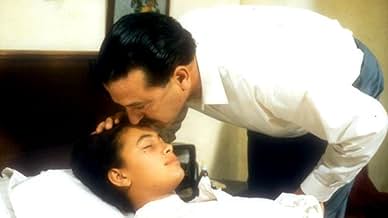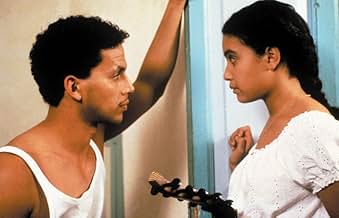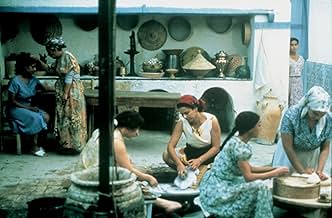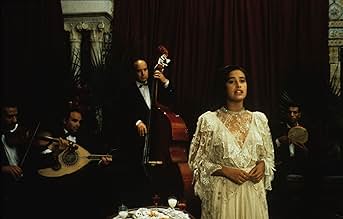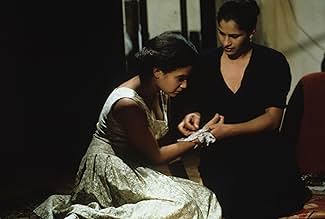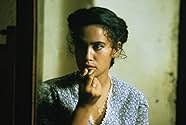PUNTUACIÓN EN IMDb
7,3/10
1,2 mil
TU PUNTUACIÓN
Añade un argumento en tu idiomaAs she grows up, Alia (the daughter of housemaid Khedija) learns the secrets of the peaceful palace where she and her mother live.As she grows up, Alia (the daughter of housemaid Khedija) learns the secrets of the peaceful palace where she and her mother live.As she grows up, Alia (the daughter of housemaid Khedija) learns the secrets of the peaceful palace where she and her mother live.
- Premios
- 7 premios en total
Hind Sabri
- Alia
- (as Hend Sabri)
- …
Ghalya Lacroix
- Alia
- (as Ghalia Lacroix)
- …
Nejia Ouerghi
- Khalti Hadda
- (as Najia Ouerghi)
Argumento
¿Sabías que...?
- ConexionesFeatured in Women Make Film (2018)
Reseña destacada
Set in 1950s Tunisia at the end of the French colonial rule, Moufida Tlatli's first directorial feature film encompasses a politically charged era through social dynamics, feminist vision and artistic choices, including - but not limited to - the first appearance of Hend Sabry, who went on to become one of the leading actresses of Tunisian and Arab cinema.
"The Silences of the Palace" tells the story of Alia, a nightclub singer visiting the bey's palace, where she grew up as the daughter of a servant. Upon her return, Alia embarks on reminiscing her adolescence and girlhood, uncovering the ghosts of her past and a murky family history.
"We were taught one rule in the palace: Silence", said one woman protagonist in the movie.
Clashes between Tunisian nationalist forces and the French forces are conveyed exclusively through radio reports, as we accompany the characters during curfews. Introducing well-developed female characters in a light and funny dialogue, the film also portrays their struggles in the monarch's palace and in the city at large. Ultimately, the "silence" here refers to the one covering sexual violence. However, the film offers hope subtly, in its enforcement of Arab women's voices in spaces where they were silenced.
This rebellious use of sound recalls the feminist movement's connection to music. The first wave of the feminist movement that occurred at the end of the 19th and early 20th centuries adapted soldier's songs for marches, borrowed tunes from popular songs and composed songs based on hymns, creating anthems about women suffrage. Whereas in the second wave (1960 - 1980), female bands created a specific genre within the punk rock genre, narrating the female experience and demands for justice.
Not only are the women of "The Silences of the Palace" singing labor songs in most of their scenes, but also the main character's voice defiantly sets the tone for the entire film. Through it, we are sent into a deep dive of musical heritage (put together by Anouar Brahem and Faouzi Thabet), whether Um Kalthoum's songs handpicked to feel like subtle messages to the beys, or the rebels' anthem that plays a key factor in the film's climax.
"The Silences of the Palace" could be defined as a coming-of-age story of a musician, whose act of singing was her coping mechanism under patriarchal and colonial rule; it was her tool of resistance, her means of communication with different social classes and her chaperone for more hopeful possibilities.
One cannot overlook the other cinematographic elements of the film. The cinematography and costume design offer general shots that act as art installations; we are told of entanglement through a scene of hands intertwining and told of mystery through a chase scene occurring in a traditional setting. The set designer's rich use of color and poignant classical details are visible in the halls, the bedrooms and the living rooms inhabited by the bey's family. Mirrors exhibit their duality, affairs and detachment. Lack of white in the space underlines the darkness behind luxury. Their materialism contrasts with the empty space occupied by the servants; an underground floor surrounded with white walls and fabric.
In remembrance of Moufida Tlatli, Hend Sabry wrote: ""Mova": the woman, the mother, the resonant voice, harboring a delicate emotion that tired her and made her create cinematic masterpieces at the same time... I miss you while you are alive, and I will miss a part of myself after your departure, and Arab cinema has missed one of its greats today."
"The Silences of the Palace" tells the story of Alia, a nightclub singer visiting the bey's palace, where she grew up as the daughter of a servant. Upon her return, Alia embarks on reminiscing her adolescence and girlhood, uncovering the ghosts of her past and a murky family history.
"We were taught one rule in the palace: Silence", said one woman protagonist in the movie.
Clashes between Tunisian nationalist forces and the French forces are conveyed exclusively through radio reports, as we accompany the characters during curfews. Introducing well-developed female characters in a light and funny dialogue, the film also portrays their struggles in the monarch's palace and in the city at large. Ultimately, the "silence" here refers to the one covering sexual violence. However, the film offers hope subtly, in its enforcement of Arab women's voices in spaces where they were silenced.
This rebellious use of sound recalls the feminist movement's connection to music. The first wave of the feminist movement that occurred at the end of the 19th and early 20th centuries adapted soldier's songs for marches, borrowed tunes from popular songs and composed songs based on hymns, creating anthems about women suffrage. Whereas in the second wave (1960 - 1980), female bands created a specific genre within the punk rock genre, narrating the female experience and demands for justice.
Not only are the women of "The Silences of the Palace" singing labor songs in most of their scenes, but also the main character's voice defiantly sets the tone for the entire film. Through it, we are sent into a deep dive of musical heritage (put together by Anouar Brahem and Faouzi Thabet), whether Um Kalthoum's songs handpicked to feel like subtle messages to the beys, or the rebels' anthem that plays a key factor in the film's climax.
"The Silences of the Palace" could be defined as a coming-of-age story of a musician, whose act of singing was her coping mechanism under patriarchal and colonial rule; it was her tool of resistance, her means of communication with different social classes and her chaperone for more hopeful possibilities.
One cannot overlook the other cinematographic elements of the film. The cinematography and costume design offer general shots that act as art installations; we are told of entanglement through a scene of hands intertwining and told of mystery through a chase scene occurring in a traditional setting. The set designer's rich use of color and poignant classical details are visible in the halls, the bedrooms and the living rooms inhabited by the bey's family. Mirrors exhibit their duality, affairs and detachment. Lack of white in the space underlines the darkness behind luxury. Their materialism contrasts with the empty space occupied by the servants; an underground floor surrounded with white walls and fabric.
In remembrance of Moufida Tlatli, Hend Sabry wrote: ""Mova": the woman, the mother, the resonant voice, harboring a delicate emotion that tired her and made her create cinematic masterpieces at the same time... I miss you while you are alive, and I will miss a part of myself after your departure, and Arab cinema has missed one of its greats today."
- hosamomran
- 20 abr 2021
- Enlace permanente
Selecciones populares
Inicia sesión para calificar y añadir a tu lista para recibir recomendaciones personalizadas
- How long is The Silences of the Palace?Con tecnología de Alexa
Detalles
Contribuir a esta página
Sugerir un cambio o añadir el contenido que falta

Principal laguna de datos
By what name was Los silencios del palacio (1994) officially released in Canada in English?
Responde


